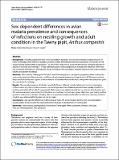Por favor, use este identificador para citar o enlazar a este item:
http://hdl.handle.net/10261/141692COMPARTIR / EXPORTAR:
 SHARE SHARE
 CORE
BASE CORE
BASE
|
|
| Visualizar otros formatos: MARC | Dublin Core | RDF | ORE | MODS | METS | DIDL | DATACITE | |

| Título: | Sex-dependent differences in avian malaria prevalence and consequences of infections on nestling growth and adult condition in the Tawny pipit, Anthus campestris |
Autor: | Calero-Riestra, María CSIC ORCID; García, Jesús T. CSIC ORCID | Palabras clave: | Anthus campestris Tawny pipit Plasmodium Haemoproteus Avian malaria Infection Nest predation Host age Host sex Nestling growth |
Fecha de publicación: | 2016 | Editor: | BioMed Central | Citación: | Malaria Journal 15: 178 (2016) | Resumen: | [Background]: Parasites play pivotal roles in host population dynamics and can have strong ecological impacts on hosts. Knowledge of the effects of parasites on hosts is often limited by the general observation of a fraction of individuals (mostly adults) within a population. The aim of this study was to assess the prevalence of malaria parasites in adult (≥1 year old) and nestling (7-11 day old) Tawny pipits Anthus campestris, to evaluate the influence of the host sex on parasite prevalence in both groups of age, and explore the association between infections and body condition (adults) and growth (nestlings). [Methods]: Two hundred Tawny pipits (105 adults and 95 nestlings) from one Spanish population were screened for avian malaria parasites (Haemoproteus and Plasmodium) using the polymerase chain reaction (PCR)-based methods. Body condition (body mass against a linear measure of size) was measured in adults and growth rate (daily mass gain) was calculated for nestlings. [Results]: The overall prevalence of infection was 46 %. Sixteen different mitochondrial cytochrome b haplotypes of Plasmodium spp. and one Haemoproteus spp. haplotype were found. Malaria parasites were equally prevalent in nestlings and adults (45 and 46 %, respectively). Males were more likely to be infected by parasites than females, and this sex-bias parasitism was evident in both adults and nestlings. Furthermore, a lower daily mass gain during nestling growth in males than in females following infections were found, whereas the effect of infections on body condition of adults was detrimental for females but not for males. [Conclusions]: Age-specific differences in physiological trade-offs and ecological factors, such as nest predation would explain, at least in part, the observed host sex and age-related patterns in Tawny pipits. | Versión del editor: | https://doi.org/10.1186/s12936-016-1220-y | URI: | http://hdl.handle.net/10261/141692 | DOI: | 10.1186/s12936-016-1220-y | Identificadores: | doi: 10.1186/s12936-016-1220-y issn: 1475-2875 |
| Aparece en las colecciones: | (IREC) Artículos |
Ficheros en este ítem:
| Fichero | Descripción | Tamaño | Formato | |
|---|---|---|---|---|
| Anthus campestris.pdf | 2,31 MB | Adobe PDF |  Visualizar/Abrir |
CORE Recommender
PubMed Central
Citations
12
checked on 22-may-2024
SCOPUSTM
Citations
39
checked on 18-may-2024
WEB OF SCIENCETM
Citations
37
checked on 25-feb-2024
Page view(s)
238
checked on 23-may-2024
Download(s)
268
checked on 23-may-2024

